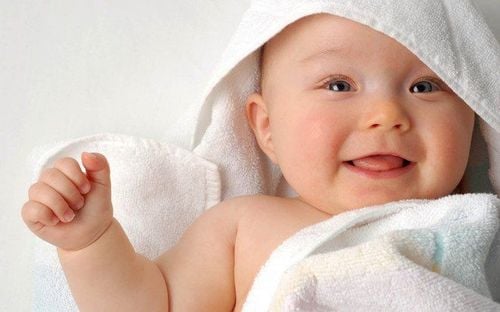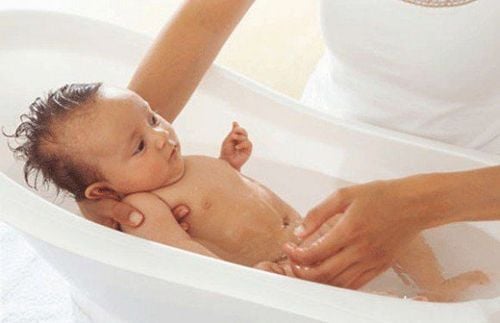This is an automatically translated article.
The simplest way to avoid bathroom injuries is to keep children away from the bathroom unless accompanied by an adult. This means that you need to latch the door at an adult level so that the child can't get to the bathroom on his own in your absence. In addition, there are some safe ways to bathe your baby that you can do at home.
1. When should babies have their first bath?
Recommended time for baby's first bath has changed over the past few years. While most medical facilities typically bathe babies within an hour or two of birth, many facilities are changing the process.
The World Health Organization (WHO) recommends delaying the first bath of a newborn until 24 hours after birth or waiting at least 6 hours for cultural reasons.
Here are some reasons why we should delay the baby's first bath:
Body temperature and blood sugar: Babies bathed right after birth can be susceptible to colds and hypothermia. The little stress that comes with an early bath can also make some babies more susceptible to low blood sugar. Bonding and breastfeeding: Bathing babies too soon can disrupt skin-to-skin care, mother-infant bonding, and early breastfeeding. One study found that breastfeeding success rates in the hospital increased by 166% after a 12-hour delay in a baby's first bath compared with babies who were bathed within the first few hours. Dry skin: Vernix is known as a caustic, a waxy white substance that coats a baby's skin before birth, which acts as a natural moisturizer and may have anti-bacterial properties. According to the American Academy of Pediatrics (AAP), it's best to leave the irritant on an infant's skin for a while to help prevent a baby's delicate skin from drying out. This is especially important for premature babies because their skin is very vulnerable. Note: Babies born to mothers with HIV or hepatitis virus are still given a bath after their first feed to reduce the risk to hospital staff and family members.
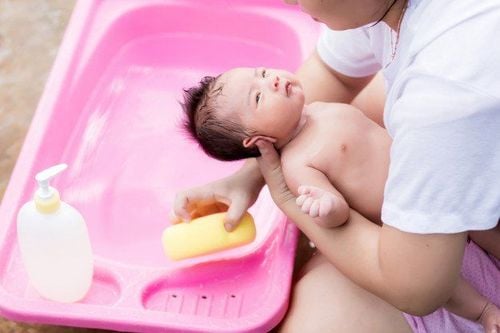
Trẻ sơ sinh cần có thời điểm tắm sau sinh thích hợp
2. How to bathe a newborn baby safely?
Newborns don't need a bath every day because they rarely sweat or get so dirty that they need regular full baths.
Three baths per week for a baby's first year may be enough. Bathing more often can dry out your baby's skin.
Once the navel area has healed, you can try placing your baby directly into the water. Your baby's first bath should be gentle and go as quickly as possible. Children may object a little. If this happens, go back to sponge baths for a week or two, then try showering again. Baby bath safety tips :
Use an infant bath. The US Consumer Product Safety Commission recommends using a hard plastic tub with a sloped, textured surface or a sling to keep your baby from slipping. Only use infant bath tubs manufactured on or after October 2, 2017 that meet applicable safety standards. Some parents find it easiest to bathe their newborn in a tub, sink, or plastic tub lined with clean towels. Avoid using a shower chair. These chairs support so that the child can sit upright in the adult bath. Unfortunately, these products can be slippery and can cause children to fall into the water and drown. Have towels and other bathing supplies within easy reach so you can always help your baby. If you forget something or need to answer the phone or open the door for a visitor while bathing your baby, you should take the baby with you. Start practicing infant drowning prevention now. Never leave a child alone in the bath, even for a moment. Most child drownings at home occur in a bathtub, and more than half of all bathtub deaths occur in children under the age of 1. Check water temperature. Fill a basin with about 2 inches of warm water, testing the temperature on the inside of your wrist or elbow. If you're filling the basin with water from the faucet, turn the cold water on first (and off last) to avoid scalding yourself or your baby. The American Academy of Pediatrics (AAP) recommends that the hottest point at the faucet be no more than 120 degrees Fahrenheit to avoid burns. In many cases, you can adjust your water heater settings to not exceed this temperature. Tap water that is too hot can quickly cause burns so severe that they require hospitalization or even surgery. In fact, hot water is the leading cause of burns in babies and young children.
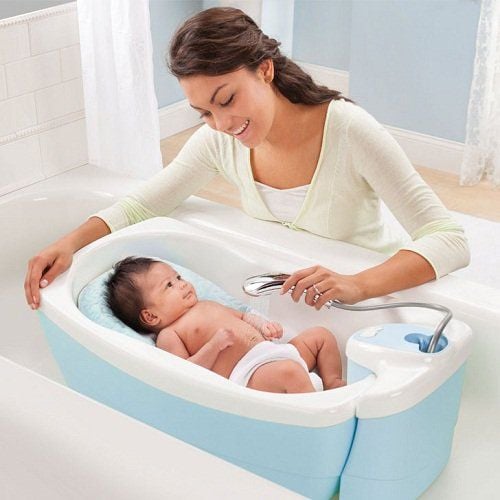
Mẹ cần kiểm tra nhiệt độ nước tắm vừa phải tránh để trẻ bị bỏng
Keep baby warm. After you undress your baby, put him in the water immediately so he doesn't get cold. Use one of your hands to support the baby's head and the other hand to guide the baby in with your front foot. Talk to your baby for encouragement and gently lower the rest of his body until he's in the tub. Most of the baby's body and face should be above water level to be safe, so you'll need to regularly add warm water to the tub to keep your baby warm. Limit soap use. Soap can dry out your baby's skin. If shower gel is needed on heavily soiled areas, use only mild, pH-neutral soaps with no additives. Wash the soap off the skin immediately. Wash your baby's hair two or three times a week with a mild shampoo or body wash. You may see some scaly patches on your baby's scalp called infant seborrheic dermatitis (cradle cap), which is a harmless condition that occurs in many babies. You can loosen the flakes with a soft-bristled brush when you wash your hair in the bath, but you can also leave the flakes alone. Gently clean. Use a soft towel to wash your baby's face and hair, be careful not to rub or tug at the skin. Gently massage your baby's entire scalp, including the fontanelle area. When you wash the shampoo off your child's head, place your hand over his or her forehead so that the shampoo flows out to the sides rather than into the child's eyes. If some stains get into your eyes, use a wet cloth to wipe with warm water. Bathe the rest of the child's body from the top down. Have fun in the bath. If your baby loves baths, give her a little extra time to splash and play in the water. The more fun your child has in the bath, the less afraid he will be of the water. Bathing will be a very relaxing and soothing experience, so don't rush it too quickly unless your child is unhappy. Newborns don't really need toys when bathing, because just being in the water is enough to be interesting for them. However, when your baby is old enough to get into the tub, toys can make it even more fun. Get out and dry. When the bath is over, quickly wrap a towel around your baby's head and body to help keep her warm while she's still wet. Bathing babies of all ages is wet business, so you can wear a cotton apron or a scarf around your shoulders to stay dry. Gently pat your baby dry and apply a small amount of fragrance-free, hypoallergenic moisturizer immediately after bathing to help prevent dry skin or eczema.
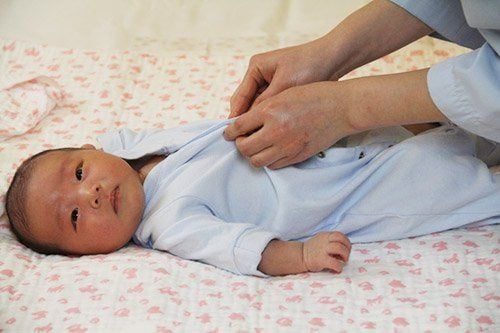
Lau khô người cho trẻ ngay sau khi tắm xong
3. Seven mistakes when bathing children
Abandon your child
Sometimes, you will step away from your child to get a forgotten item or take your phone while your child is in the bath. But leaving your child alone for even a few seconds is too long. Before you start giving your baby a bath, take the time to make sure that everything you need is within reach.
Don't lock the bathroom
Although most parents realize that tubs filled with water are dangerous during bath time, an entire bathroom can actually be dangerous for your child at any time. during the day.
Bathtubs and even toilets can pose a drowning risk for young children, so it's important to limit your child's access to the bathroom by installing a lock on the bathroom door and adding a latch on the toilet bowl. .
Ignore slip hazards
The surface of the tub is very slippery when wet, which increases your child's chances of slipping or falling. Anti-slip bath with anti-slip strips and these products are easy to install to the bottom of the tub.
Alternatively, you can use silicone caps to cover hard metal handles, faucets and faucets. This can reduce bumps if your child hits his or her head or slips and falls on these devices.
Do not test the water temperature
Hot bath water can burn children's skin, which is more sensitive than adult skin.
To eliminate the risk of burns, adjust your water heater, if possible, so it never goes above 120 degrees F.
You should also test the water temperature yourself before placing your child in it. tub.
Remember to test the water on your wrist or elbow instead of just your finger because your fingers can handle hotter temperatures.
Fill up the tub
There is nothing more enjoyable than bathing in a tub full of water. But using more than a few inches of water is dangerous for young children. Children can drown in as little as 3 or 4 inches of water if their faces are submerged, experts warn.
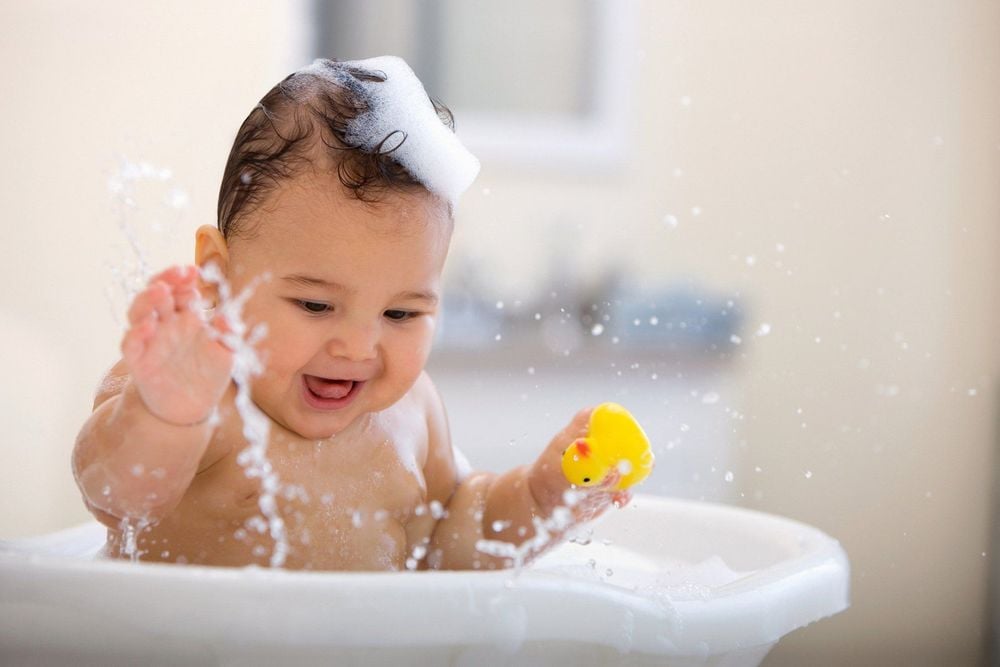
Không để nước quá đầy bồn tắm cho trẻ
Bathing in bubbles and sponges
Bathing in bubbles, while fun, can irritate your child's sensitive skin. So skip the foam and choose a baby-friendly body wash or shampoo that is fragrance-free or sensitive.
Using washcloths is a great way to help clean your child - but be careful with sponges as they are a breeding ground for bacteria if the sponges don't dry completely between baths.
Letting your baby play with old toys in the bath
Although toys are a joy for babies during bath time, it is important that you choose the right toys.
Do not choose toys that are too small as they may pose a choking hazard. And be careful with toys that in the shower can hold water. Like sponges, these toys are a breeding ground for bacteria if they are not thoroughly dried after each bath.
Children need to provide enough elemental zinc/day for them to eat well, reach the correct height and weight and exceed the standard. Zinc plays a role in affecting most biological processes taking place in the body, especially the breakdown of nucleic acids, proteins... Organs in the body when zinc deficiency can lead to a There are a number of diseases such as neurological disorders, irritability, etc. Therefore, parents need to learn about the role of zinc and guide them to appropriate zinc supplements for their children.
In addition to zinc, parents also need to supplement their children with other important vitamins and minerals such as lysine, chromium, B vitamins,... errands.
Please regularly visit Vinmec.com website and update useful information to take care of your baby and family.
Reference article source: babycenter.com





